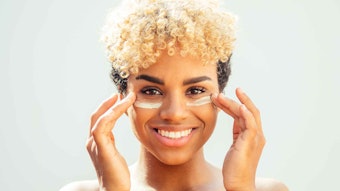
Read this article in its entirety in the September 2020 digital edition. . .
When it comes to formulating, few substances in their pure state have adequate characteristics for easy surface diffusion, adherence, aesthetics, stability and long lasting effects on the skin. Moreover, it is unclear whether an ingredient applied alone on the skin would work better than when blended in a mixture with other substances.
The act of formulating in and of itself refers to assembling well-identified raw materials in a correct ratio with the aim of obtaining a cosmetically functional whole. As such, a clear-cut distinction between active ingredients and excipients is non-existent in a traditional cosmetic product. Rather, it is more accurate to speak of the formula’s assembly of functional substances that have one or more specific activities; e.g., antioxidant, soothing, moisturizing, etc. These are formulated together with a “vehicle” to make them promptly available on the skin surface. Unlike pharmaceutical excipients, however, the vehicle is neither inert nor foreign to the cosmetic activity but contributes to it, largely modifying the properties of the skin and the substances that the vehicle itself carries.
In contrast, for several months now, the world has been talking about “clean” beauty as an up-and-coming trend. What does this mean? An internet search makes it quite evident that this idea concerns the formulation of cosmetic products that are simple and efficient, safe, ethical and sustainable. Notably, this is different from cosmetics claiming to simply be natural, organic, green or some combination thereof, and it identifies a more sophisticated concept that “less is more.”
The trend is also self-fulfilling. According to one news report, “it wasn’t until products started calling themselves ‘clean’ [that] a critical mass of consumers started noting ingredient lists…with the diligence of parents checking children’s hair for lice.”1
The present article outlines how to craft “clean” beauty formulas. It reviews consumer perception, provides ways to go about such a formulation project, outlines the best ingredients to use and describes important product categories to address.
Consumer Perception
The “clean” beauty trend started from the consumer’s perception of cosmetic products as containing what they deemed to be “useless” ingredients. These ingredients were believed to bring zero benefits to skin—indeed, quite the opposite; they were believed to damage the skin and the environment. These assumptions appear unrelated to the trend for “100% organic” or “natural” brands. In fact, consumer demands for “clean” beauty products are quite different. These include:
- Transparency of the formulation. If it is not obvious from the label that a product is “clean”—and many times, even when it is—the consumer wants to know exact information related to the product’s ingredients. For example, which ingredients are used? How many are there and why?
- Simplicity of the ingredients list. This poses a real challenge for the formulator but by using simple raw materials rather than a mixture of substances with undesirable excipients, i.e., preservatives, stabilizer, etc., the formulator can simply check for impurities and streamline the INCI list.
- Transparency of claims. Does it work? How did the company verify its efficacy?
- Eco-consciousness. What has been done to minimize the impact on the environment of producing the final product? For instance, is it sold in recycled containers? Or was less water consumed in the formula, or during production?
- Safety. It is evident that the majority of cosmetic products are generally safe if used correctly. In the purest sense, product safety is strictly related to the ability of the formulator to select the right combination of ingredients for the specific consumer target and to assemble them in such a manner as to avoid stability and compatibility problems over time. This is about more than mere “free-from. . .” claims.
From the looks of this “clean” beauty trend, the cosmetics R&D world is circling back to the basics, to the “ancient” art of formulating. This means properly combining selected raw materials to obtain a functional and pleasant cosmetic product with properties above and beyond the simple sum of its ingredients.
Indeed, formulating cosmetics means obtaining a balanced whole that is pleasant to use, stable over time, safe for consumers and operators, and not harmful to the environment. It also should be economically affordable, easily manufactured and transportable, and fulfill the quality characteristics expected by the market. Taken together, crafting the best combination of ingredients from a universe of more than 10,000 possible substances—without even considering fragrance, which adds at least 5,000 more—means one could, in theory, obtain infinite possibilities.
Top ‘Clean’ Ingredients
Ingredients that perform several functions should be at the heart of cosmetics with simple, sustainable and easy-to-read formulas.
Polymers: Polymers provide one example. This useful category of ingredients serves multiple functions; from thickening and emulsifying to film-forming. Within this category, the gelatin-like polysaccharide carrageenan was more recently identified. This family of high molecular weight sulfated polysaccharides is obtained by extraction from certain species of red seaweeds.
Carrageenan is widely utilized due to its excellent physical functional properties such as gelling, thickening, emulsifying and stabilizing capabilities.2, 3 Moreover, when applied to skin, carrageenan is capable of enhancing the permeability and effectiveness of skin moisturizing and care products such as lotions and creams.4
Formulating aids: Multifunctional formulating aids such as pH correctors also can work as chelating agents, e.g., citric acid; or as soothing actives, such as lactic acid. In addition, one demonized solvent, ethanol, acts as a vehicle for numerous actives to improve their solubility; as a preservative; and easily evaporates, reducing its impact on the skin.
Antioxidants: Antioxidants in topical products perform a double function. First, they protect the delicate ingredients in a formula from oxygen, maintaining their concentration and functionality during the shelf life of the product. They also transport into skin to increase cellular antioxidant defenses, especially those challenged by environmental assaults such as UV and pollution, where they locally quench excess ROS.
Vitamins: Vitamins fulfill many contemporary biological functions, including inducing collagen synthesis, restoring the reduced form of glutathione in cells, depigmenting skin and quenching free radicals.5, 6
Vegetable oils: Vegetable oils, e.g., olive, argan and soybean, if well-protected from oxidation through the correct use and combination of antioxidants, can act as a vehicle and rich mixture of beneficial ingredients for formulas. These contain squalene, phytosterols, phenolic compounds, etc. These can improve numerous skin characteristics, from elasticity to hydration; can impart additional antioxidant effects; and can restore skin’s balance.7
Hemp seed oil: Another multifunctional vegetable oil worth highlighting is hemp seed. Compared with other vegetable oils, it is especially rich in both omega-3 and omega-6 essential fatty acids; more specifically, linoleic acid, 55%; alpha-linolenic acid, 20%; gamma-linolenic acid, 1-4%; and stearidonic acids, 0.5-2.0%.8 It also contains a high amount of tocopherols and tocotrienols (0.10%-0.15%), phytosterols, phospholipids, carotenes and minerals.9
Clinical studies have shown that polyunsaturated fatty acids (PUFAs) can alleviate or even resolve skin problems such as dry skin.10 Hemp seed oil protects the skin by reducing dryness and may even slow the skin’s aging process. Moreover, it is an eco-friendly crop requiring no biocides and little fertilizer, in comparison with other plants.11
Formulation Approach
Formulating “clean” products begins by drafting a list, as extensively and detailed as possible, of the desired functions of the final product. Think broadly; for example, primary functions may include not only skin protection and cleansing effects, but also chemical and microbiological stability; safety during acute and chronic use; organoleptic and sensorial characteristics; performance during use; and claimed efficacy. Of course, the higher the number of claims, the higher the number of ingredients, so a step back to simpler products is necessary for “clean” beauty formulas. These should be narrowed down to no more than one, perhaps two claims, maximum.
Also, monophasic systems such as aqueous solutions for serums, mists, micellar waters, etc., or anhydrous systems for oil solutions, lipo-gels, dry powders, etc., may be more appropriate for “clean” beauty. Aqueous solutions, being water-based, convey pure, “clean” and sustainable concepts. Serums also have evolved, delivered in creative ampoules or as boosters. In fact, in the past year, a significant number of brands has reported large increases in the sales of serums/ampoules.12-14 These formulas typically contain a balanced combination of only a few ingredients, i.e., water plus one polymer and a humectant to give the best skin feel; perhaps a selection of two to three actives may also be added to perform a required effect.
Note that “clean” beauty products are typically designed for a single function; i.e., depigmentation, revitalization or moisturization—not multiple functions together. As such, the following examples offer suggestions for single-focused, “clean” beauty formulas.
Example 1: Skin Lightening Formulation
As shown by Formula 1, different strategies can be combined to impart skin lightening effects. The melanin synthesis pathway, for example, can be disrupted during melanosome formation or during the transport of melanin within melanosomes. Moreover, the molecular biology of the melanogenesis process can be influenced, such as through tyrosine gene expression and intercellular signaling. The optimal approach for the greatest efficacy is to combine skin lighteners with different mechanisms of action that work in synergy within the formulation; or ideally, in the case of “clean” beauty, to utilize a single ingredient that performs multiple actions.
The most frequent approach to skin lightening is through the enzymatic inhibition of tyrosinase. This is achieved by employing active substances such as ascorbic acid, arbutin, kojic acid and hydroquinone.
. . .Read more in the September 2020 digital edition. . .
References:
- ElBoghdady, D. (Mar 11, 2020). ‘Clean’ beauty has taken over the cosmetics industry, but that’s about all anyone agrees on. Washington Post. Https://www.washingtonpost.com/lifestyle/wellness/clean-beauty-has-taken-over-the-cosmetics-industry-but-thats-about-all-anyone-agrees-on/2020/03/09/2ecfe10e-59b3-11ea-ab68-101ecfec2532_story.html (accessed on June 2020).
- Campo, V. L., Kawano, D. F., Silva, D. B., Jr. and Carvalho, D. I. (2009). Carrageenans: Biological properties, chemical modifications and structural analysis—A review. Carbohydrate Polymers 77 167–180.
- Kavitha Reddy, G. K. M., Satla, Shobharani, and Gaikwad, Switi. (2011). Natural polysac-charides: Versatile excipients for controlled drug delivery systems. Asian J Pharma Sci 6 275–286.
- Valenta, C. and Schultz, K. (2004). Influence of carrageenan on the rheology and skin permeation of microemulsion formulations. J Control Release 95.2 257-265.
- Burgess, C. (Jul 7, 2011). Topical vitamins. J Drugs Dermatol 7 Suppl s2-s6.
- Stanley, S. S., et al. (Oct 2001). Role of vitamins in skin care. Nutrition 17(10) 839-844.
- Vaughn, A.R., Clark, A.K., Sivamani, R.K. and Shi, V.Y. (2018). Natural oils for skin-barrier repair: ancient compounds now backed by modern science. Am J Clin Dermatol 19(1) 103-117. doi:10.1007/s40257-017-0301-1
- Callaway, J.C. (2004). Hempseed as a nutritional resource: An overview. Euphytica 140 65-72. doi: 10.1007/s10681-004-4811-6.
- Grotenhermen, F. and Russo, E. (2002). Cannabis and cannabinoids: pharmacology, toxicology, and therapeutic potential. Integrative Healing Press; New York, NY.
- Sator, P.G., Schmidt, J.B. and Snigsmann, H.H. (2003). Comparison of epidermal hydration and skin surface lipids in healthy individuals and in patients with atopic dermatitis. J Am Acad Dermatol 48 352-358.
- Alden, D.M., Proops, J.L. and Gay, P.W. (1998). Industrial hemp’s double dividend: A study for the USA. Ecol Econ 25 291-301.
- Xue, F. (Jan 10, 2020). The one skincare product every Korean woman uses. Byrdie. https://www.byrdie.com/ampoules.
- Ampoules are the newest hot product in the cosmetics industry in chinca. (Oct 29, 2019). MarketingToChina. https://www.marketingtochina.com/ampoules-are-the-newest-hot-product-in-the-cosmetics-industry-in-china/
- Skincare serums market forecast, trend analysis & competition tracking-global review 2019 to 2029. Fact.MR. Https://www.factmr.com/report/3973/skincare-serums-market











